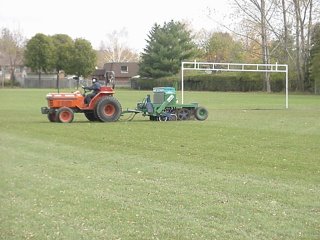Lawn & Garden Info in the Blogosphere
Welcome to the new on-line "blog" version of the GTI Lawn & Garden Letter. The primary reason for moving to this format is two-fold. One, it is much easier for me to post short snippets of seasonal advice rather than pull together a complete Lawn & Garden Letter. Hopefully that means more posts and more timely information that gets out to you. Secondly, it allows subscribers to easily sign up (or off) as you wish. Please use the easy email signup to the right if you wish to subscribe to the new version of the letter. It will mail new posts directly to your inbox as soon as they are posted. I hope you like the new format and I would certainly welcome your comments and suggestions.
Overseeding

A few weeks back I responded to a rather vague article that appeared in the Toronto Star concerning lawn care without pesticides in the Greater Toronto Area. I'm not a regular Star reader but apparently my response made "Letter of the Day" and I was immediately innundated with inquiries about overseeding which was one of the main points I made in my comments to the newspaper. Here is my elaboration....
Overseeding is the act of sowing grass seed within an existing turf area. It is typically done to increase the density of grass plants in a thin lawn or to repair a damaged lawn. The photo above shows a sports field being overseeded with a special machine in the fall to repair damage from summer play. In areas like Toronto and other municipalities where pesticides have been banned or severely restricted, lawn overseeding will play a more significant role in maintaining a functional turfgrass surface.
For most areas of southern Ontario, perennial ryegrass is the preferred species for overseeding purposes. Perennial ryegrass has a large seed that germinates quickly. Most other turfgrasses do not fare as well when broadcast into the competitive environment of an existing lawn. Unfortunately, it is somewhat difficult to locate straight perennial ryegrass seed. Some garden centres have bulk bins that include an overseeding mixture that is 100% perennial ryegrass. Sometimes you can find it labelled as "Quickgrass" or similar name. Search the small print of the label to see that it is predominantly perennial ryegrass. Hopefully as the benefits of overseeding with perennial ryegrass become better known, it will become more readily available.
The most commonly found Kentucky bluegrass is still the best lawn grass but unfortunately it performs very poorly as an overseeding grass. It lacks the competitive vigour of perennial ryegrass and also takes several weeks to fully germinate whereas perennial ryegrass is usually up in a few days.
In order to prepare your lawn for overseeding, rake the damaged areas vigorously to remove any dead material and expose the soil. Good seed to soil contact is essential for successful seed germination. An alternative for larger areas would be to either use a vertical mower to chew out some of the dead material - you will still have to rake it up but it will be much easier once the vertical mower has lifted it up. Another alternative is to make several passes with a core aerator - one that removes an actual plug of soil and turf. The holes provide a convenient location for the seeds to germinate.
Once you have prepared the area, spread the seed over the area using a broadcast spreader or carefully by hand insuring that you distribute the seed evenly. Ten pounds of seed per 1,000 square feet is a reasonable rate. Try to overseed prior to rainfall. The ideal time to overseed is late summer to early fall although right now is pretty good as well.

<< Home